Caladium: species, care and reproduction
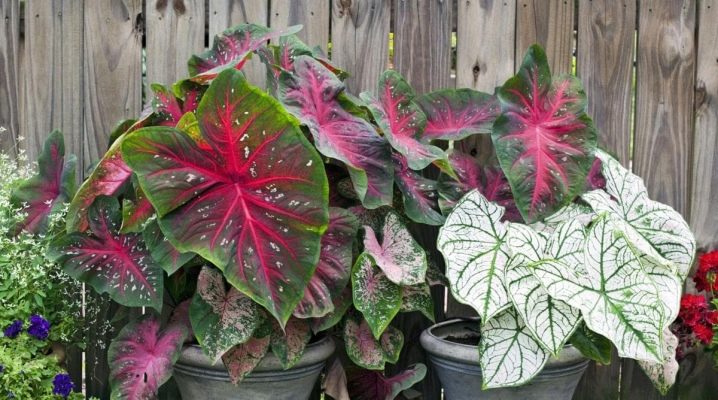
Caladium attracts attention with its beauty and pronounced decorativeness. Despite all the troubles associated with its cultivation, it is popular with decorators, florists, landscape designers and ordinary amateur florists. This plant is native to the tropics and subtropics, therefore for the successful growth of Caladium, it is necessary to create the conditions familiar to it.
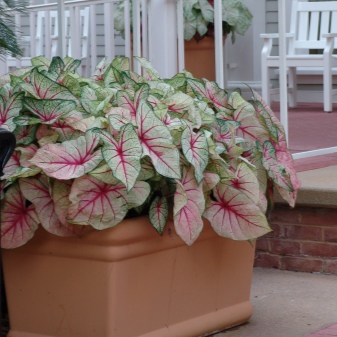
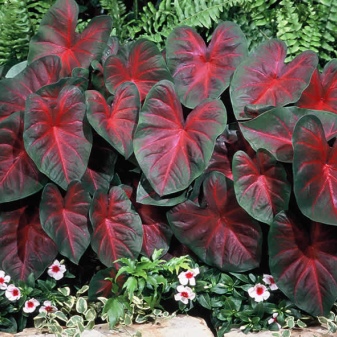
Description
Caladium is a garden or indoor plant loved by many connoisseurs of exoticism with large, elegant leaves that have a variety of colors. Their shape is often compared to that of a spearhead or heart. The veined leaves are often endowed by nature or breeders with a contrasting color, consisting of two shades. The most common colors of caladium leaves are: purple, yellow, white, red, green. This liana does not have a stem, has a root growth of leaves, which grow over time and create dense rosettes with a diametrical size of up to half a meter.
At the base of the root system of the caladium there is a roundish-flattened tuber measuring 7-10 cm in diameter, at the top of which the rudiments of the future plant are clearly visible and a little to the side are lonely sleepy buds.
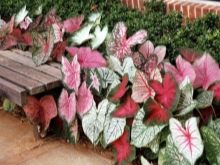
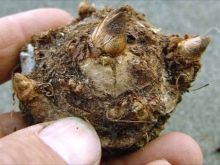
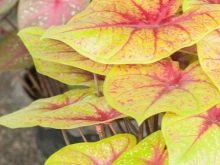
It should be noted that its inflorescence is often mistaken for a caladium flower. It appears following the opening of the third or fourth leaf and looks like a solid ear of women and men wrapped in a pointed blanket. Very often the “blanket” takes on the same color as the deciduous part. The whole process of enjoying flowers usually lasts no more than a day, and after 4-5 weeks roundish orange-red berries ripen on the spot of the inflorescence.
Caladium is a poisonous plant. It is dangerous both when it enters the esophagus, and simply when working with it.
During planting, it is necessary to protect hands with gloves, and contact of the child with this plant is strictly prohibited.
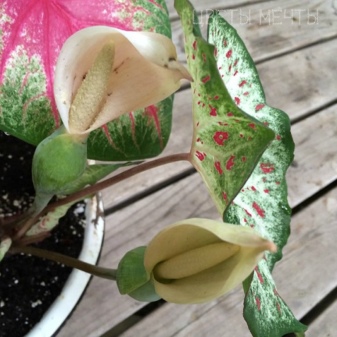
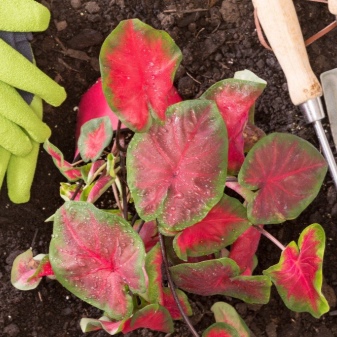
Types and varieties
Consider the popular varieties of the plant.
Caladium Humboldt
This species lies at the very foundation of breeding work on many potted hybrids. Its difference is the dark green color of the leaf plates, on the outside of which silver stripes diverge from the center, having a narrowing towards the edge. In length, leaf plates reach 10 cm and 5 cm in width. The flowers, which resemble candles in their appearance, open up in the spring, but do not carry any special decorative benefits.
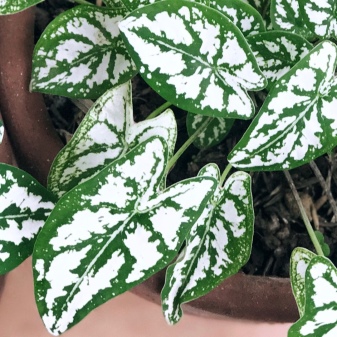
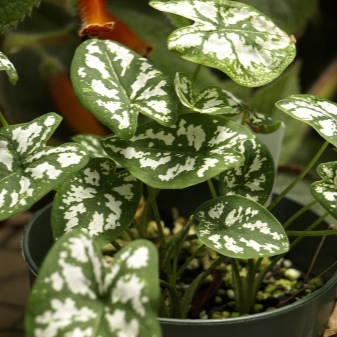
Caladium Schomburg
This variety of caladium stands out with oval leaves up to 15 cm long and up to 12 cm wide. The upper side of the leaf plate is painted in silver-reddish tones with green veins.
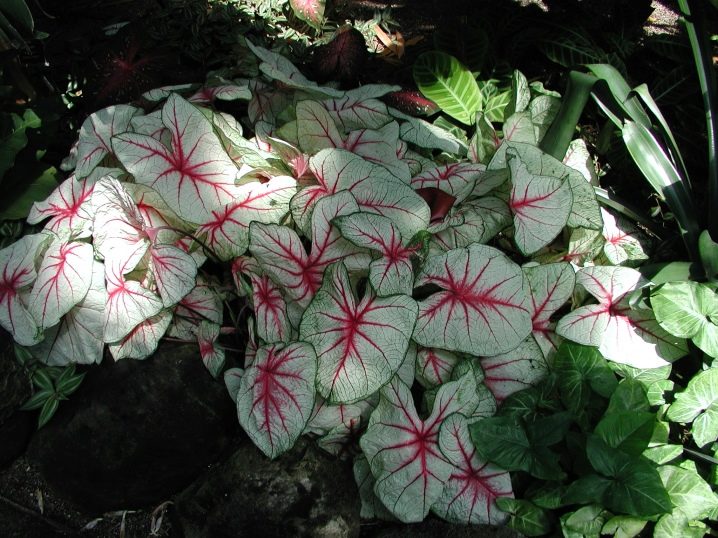
Decorative varieties:
- Venosum - on its oval green leaf plate, a red border and a vein in the center stand out, and the side veins are drawn with yellow streaks;
- Erythraeum - the dark red leaf has silver patterns along the veins.
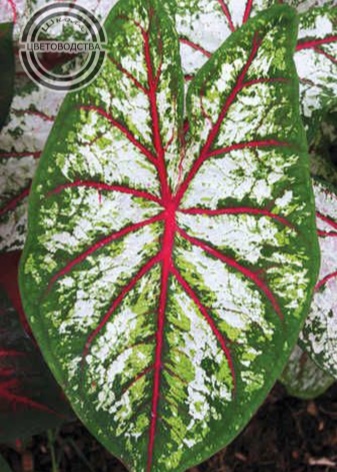
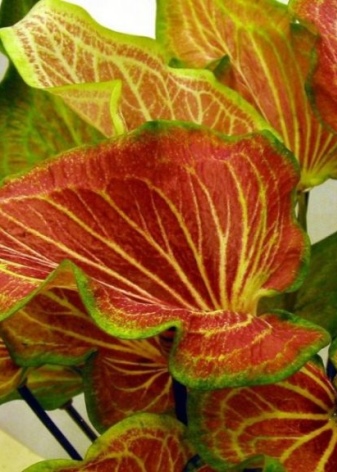
Caladium bicolor
The leaves of this species are much narrower than those of the rest, and their shape is often characterized as arrow-shaped. A bright red blot radiates from the very center along the edges with sharp tips on a green background. The length of the plate reaches 30 cm.
There are quite a few hybrid varieties.
- Rosalie - green edging is clearly visible on red leaves.

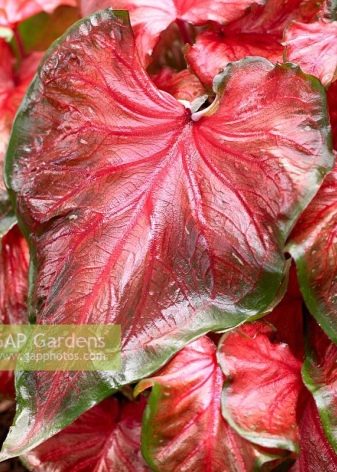
- Pink beauty - in the very center, the leaf is pink, along the edge there is a green edging, the veins are summed up with a bright pink stripe.
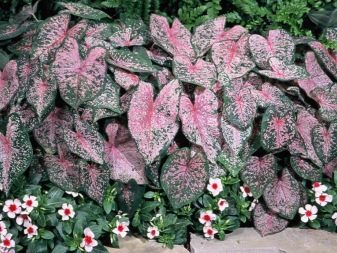
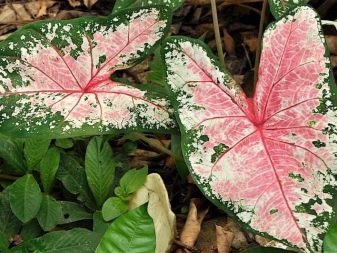
- Florida Cardinal - the leaf plates shine and are painted in a crimson hue, along the edge there is a bright green wide border.
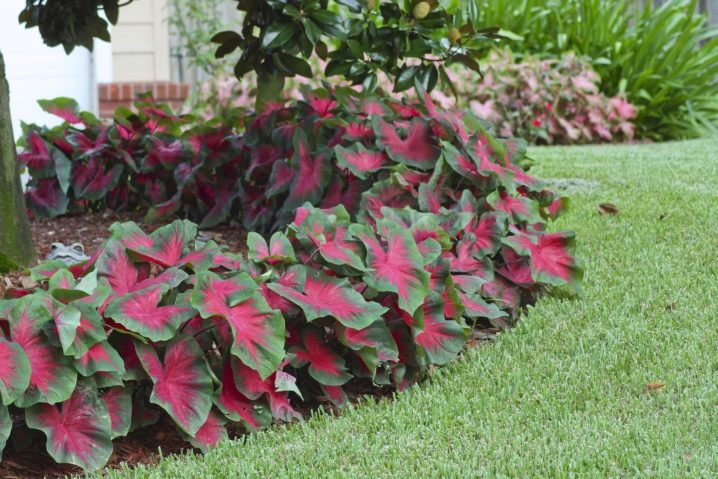
- White christmas - the surface of the leaf is silvery, on which there are dark green stripes along the veins and small dark green specks.
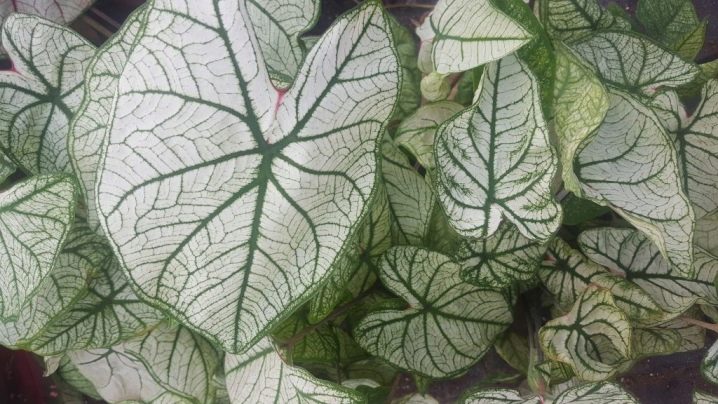
- Red Flash - the literal translation of this variety sounds like: "red flash". And this is no coincidence - the appearance of the sheet plate of the Caladium "Red Flash" resembles a photo of a bright explosion, painted in red tones. A bright crimson stripe runs along the leaf and diverges in sharp wide veins to its edges, and a scattering of light specks is located on a green background. The length of the leaf plate reaches 30 cm.
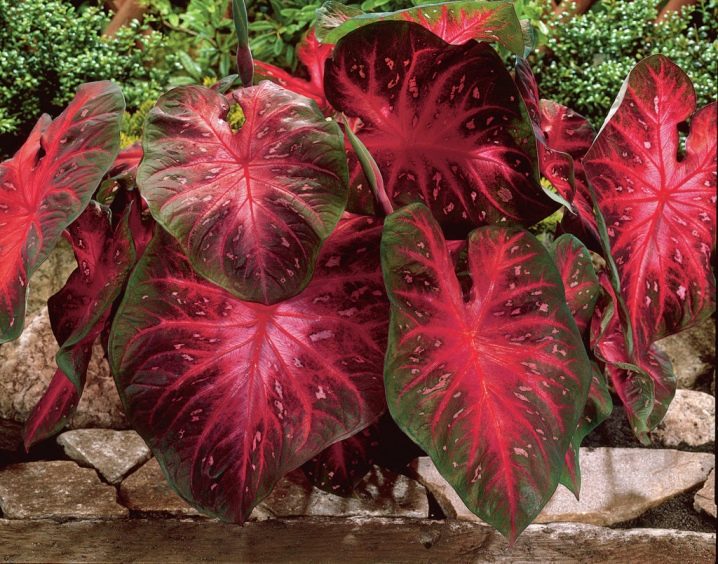
Home care
Subject to certain requirements, it is not so difficult to care for and grow Caladium on your own.
Here is a general scheme of care for plants grown in houses and apartments.
- The end of March and the beginning of April are the time when the caladium pot is brought out into the light after hibernation and ample watering is provided.
- At the same time, the comfort temperature for the natural development of caladium is in the range from +22 to +27 degrees Celsius.
- In the spring, watering should be abundant, but not excessive. The frequency of watering is approximately 1 time per week. Water that accumulates in the pan must be poured out.
- In summer, the frequency of watering is increased to twice a day, approximately 0.5 liters of water per plant.
- Watering Caladium is carried out with water at room temperature not lower than +22 degrees Celsius.
- When water drops on the leaves, they respond with dark spots. Therefore, it is important to be careful when watering.
- It is advisable to install a container with water not far from the pot so that the water evaporates and provides the moisture necessary for the flower.
- Fertilizers are applied from the end of May. In total, 2-3 dressings will be needed per season.
- With the onset of autumn, the Caladium falls asleep. Its leaves dry, and the plant itself is removed to a dark place before the onset of spring.
- During hibernation, the Caladium is also cared for. Its soil needs periodic wetting, and in order to avoid drying out, a few tablespoons of water will be enough.
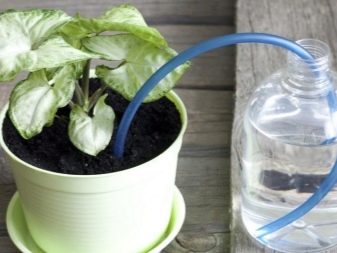
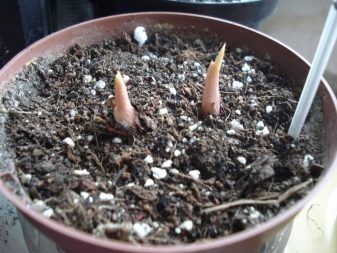
When cultivating caladium in the garden, it is planted to a moderately lit, slightly shaded place without direct exposure to ultraviolet radiation, because in his usual natural conditions, this plant is in the shadow of other plants. It is carried out abundant watering in the summer, and spraying is also encouraged.
Outdoor cultivation is carried out in a mixture from the compost component, sheet soil, sand, turf with charcoal.
In late autumn, after the leaves have dried, the tubers are dug out of the ground, cleaned of residues, sprinkled with a mixture of sand and earth, then placed in a cool place, where they are immersed in hibernation.
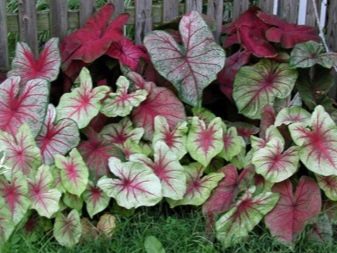
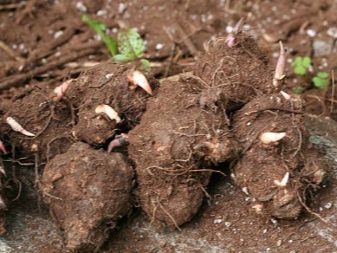
Reproduction methods
Caladium propagates in three possible ways: by daughter tubers, by dividing the tubers, and by seed.
- To propagate caladium daughter tubers, during transplantation in the spring, children are separated from the maternal tuber, placing them in a separate flowerpot or pot. This method is considered one of the most common and simplest.
- Use method of dividing tubers also pretty simple. To do this, an adult specimen must be divided into 2 or 3 parts and seated in different containers. At least one kidney must be left on each part. The division of the tuber is carried out with a disinfected knife, and the live sections are sprinkled with coal powder and planted in a sand-peat mixture. Germination is carried out in a bright and warm room with a temperature of +22.24 degrees Celsius.
- Caladium is grown seeds in order to obtain a new variety. Seeds must be purchased from specialized stores.Since this is a hybrid, it makes no sense to collect your own seeds at home, since some characteristics of the mother plants may be lost in subsequent generations. Seeds are sown in a mixture of sand with deciduous soil with regular moistening and maintaining the temperature at +30 degrees Celsius. The sprouting can be observed after 2-3 weeks, and after a month they can be planted in independent containers. In the summer season, the caladium dives again, and by the fall, small tubers are already forming.
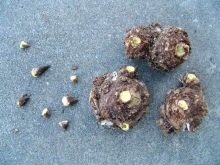
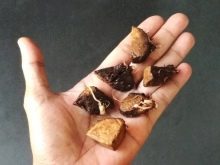
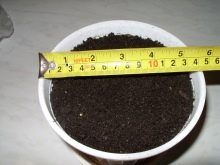
Flowering features
At the end of May, after the first 4 leaves have appeared, the development of the inflorescence begins at full speed - an elongated ear of a light shade in yellowish tones, which has turned into a white-green or leaf-colored blanket. Flowering does not occur in tandem with pronounced odors and lasts only one to several days. After pollination, dense spherical berries ripen.
It is worth noting that under indoor conditions, flowering and ripening of fruits occurs very rarely.

Diseases and pests
Caladiums, like many plants, are susceptible to various diseases and pests.
Bacterial rot
The tubers of the plant are exposed to Fusarium and wet rot. If damaged areas are found, the tubers are cut to healthy tissue using a sterile knife, and the cut sites are sprinkled with powder fungicides.
Rot prevention must be done every year when planting.
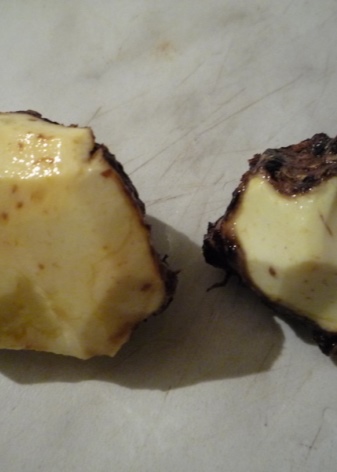

Mold on sheet plates
One of the possible reasons for the appearance of mold on the aboveground part of the caladium is waterlogging and drafts. To eliminate it, it is necessary to remove the damaged parts of the plant, reduce watering and move the pot to a place protected from drafts.
Twisted leaves
This sign may indicate a lack of watering or high air temperature. To correct the situation, increase the intensity of watering and use spraying.


Brown edges of sheet plates
In such a situation, it can be judged that the liana is too cold, and it needs to be moved to a warmer place.
Pale leaves
Very often, the pallor of the leaves is accompanied by a loss of contrast in patterns. This is usually due to a lack of sunlight. Moving the plant to a brighter place or using special lamps will help to correct the situation.
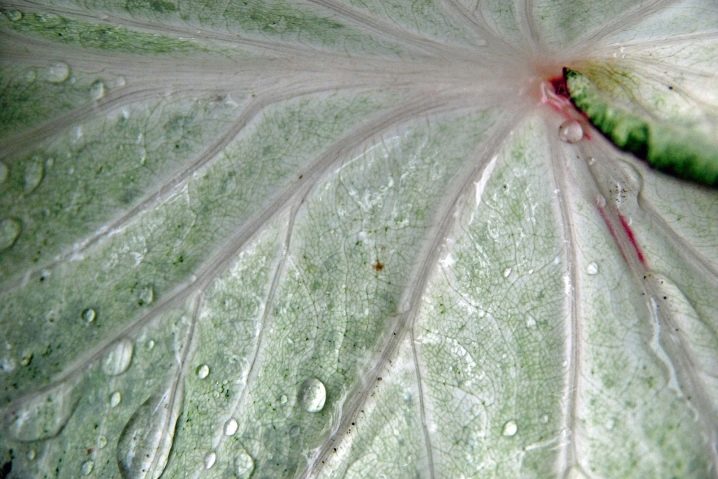
Insect damage
Aphid damage is indicated by sticky and deformed leaves. And also caladium is affected by spider mites and mealybugs. To get rid of these pests, it is necessary to use insecticides.
For caladium and caring for it, see the next video.























The comment was sent successfully.